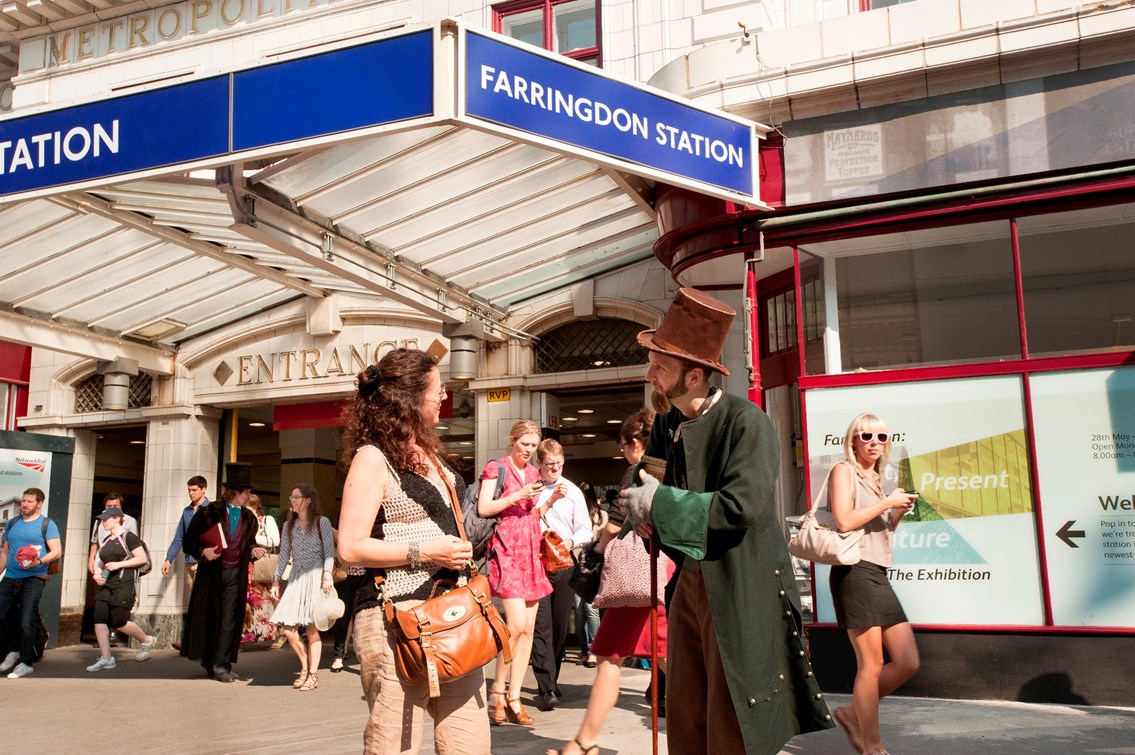Monday 28 May 2012
WHAT THE DICKENS? FARRINGDON EXHIBITION GIVES COMMUTERS A TASTE OF THE PAST AS STATION REDEVELOPMENT NEARS END
- Region & Route:
- | Southern
A free public exhibition opened at Farringdon station today, looking at the historic station’s past, present and future, as Network Rail’s project to rebuild it draws to a close.
Charles Dickens and one of his most famous literary creations, Fagin, were on hand to recount tales of Farringdon nearly 150 years ago, when the author used this part of London as inspiration for Fagin’s lair in Oliver Twist.
Farringdon station was the terminus of the world’s first underground railway. The historic station is being given a massive upgrade to preserve its heritage and provide space for new Thameslink and Crossrail services that will make it one of London’s newest transport hubs.
Speaking at the opening of the exhibition, Richard Hodder from Spectrum Drama and Theatre Projects said: “Passengers travelling through Farringdon today may be surprised to know that in the 1800s this area had one of the highest murder rates in the capital, and Turnmill Street – widely regarded as its centre – was nicknamed by locals as ‘Little Hell’."
Farringdon today combines its heritage and history with vibrant business and arts communities. The transformation of Farringdon station will continue to make the area a destination in its own right. For the past four and half years Network Rail has been redeveloping Farringdon station as part of the north-south Thameslink Programme. From 2018 Farringdon station will be the only station where Thameslink, Crossrail and Underground services meet. From Farringdon passengers will have the choice to travel north-south, east-west or around London. With 160 trains an hour in the peak it will become the capital’s newest transport hub.
Mike Brown, Network Rail’s Senior Project Manager, said: “Farringdon has a wonderful history, as the station where Underground rail travel in London began. Equipping the Victorian station for the 21st Century has been an incredible challenge, especially as we’ve kept Underground and Thameslink passengers moving through the station throughout the project.
It’s incredible to think that when it opened in1863, Farringdon Street station (as it was then called) was only served by one steam train every ten minutes during the morning peak. From 2018, once work on Thameslink, Crossrail and the Underground is complete, Farringdon will be served by 160 trains an hour during the busiest hours of the day.”
The Farringdon Crossrail station will comprise two underground platforms, each the length of two football pitches, linking two new ticket halls. The western ticket hall will be shared with Thameslink services, and will have an entrance on Cowcross Street, opposite Farringdon Underground station. The eastern ticket hall will have entrances at the Long Lane end of the station, on Lindsey Street and Hayne Street. It will link directly with the existing London Underground platforms at Barbican.
The Farringdon heritage exhibition will be open weekdays, from 8am – 8pm until Friday 29 June (excluding bank holidays). Lunchtime talks will also be given by heritage and project experts, every Thursday from 1pm -1:30pm.
Notes to editors
Network Rail is upgrading track, signalling and stations on the Thameslink route between Bedford and Brighton. The work has allowed First Capital Connect to run 50% longer, 12-carriage trains and will enable a metro-style 24 trains per hour service to run on the route in each direction from 2018.
Passengers using Farringdon station now benefit from 36 new ticket gates, 20 new staircases, a new footbridge, nine new ticket machines and two new ticket offices spread over two new entrances and a restored historic entrance.
Timelapse footage of Network Rail’s reconstruction of Farringdon station – from 2008 until today – is available at:
The Crossrail route will pass through 37 stations and run 118 km (73 miles) from Maidenhead and Heathrow in the west, through new twin-bore 21 km (13 miles) tunnels to Shenfield and Abbey Wood in the east. When Crossrail opens it will increase London's rail-based transport network capacity by 10%, supporting regeneration and cutting journey times across the city. Crossrail services are due to commence through central London in 2018.
Contact information
Passengers / community members
Network Rail national helpline
03457 11 41 41
Latest travel advice
Please visit National Rail Enquiries
Journalists
Network Rail press office - South East route
020 3357 7969
southeastroutecomms@networkrail.co.uk
About Network Rail
We own, operate and develop Britain's railway infrastructure; that's 20,000 miles of track, 30,000 bridges, tunnels and viaducts and the thousands of signals, level crossings and stations. We run 20 of the UK's largest stations while all the others, over 2,500, are run by the country's train operating companies.
Usually, there are almost five million journeys made in the UK and over 600 freight trains run on the network. People depend on Britain's railway for their daily commute, to visit friends and loved ones and to get them home safe every day. Our role is to deliver a safe and reliable railway, so we carefully manage and deliver thousands of projects every year that form part of the multi-billion pound Railway Upgrade Plan, to grow and expand the nation's railway network to respond to the tremendous growth and demand the railway has experienced - a doubling of passenger journeys over the past 20 years.
Follow us on Twitter: @networkrail
Visit our online newsroom: www.networkrailmediacentre.co.uk

